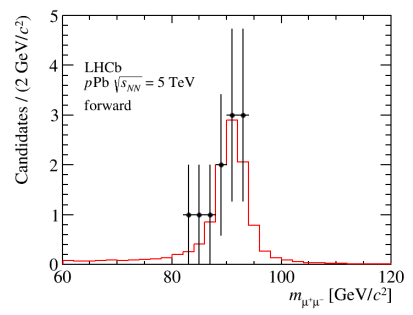Today at the 37th International Conference on High Energy Physics in Valencia, the LHCb collaboration has presented the first observation of Z boson production in proton-lead collisions at the LHC at a centre-of-mass energy per proton-nucleon pair of 5 TeV.
The main goal of lead-lead collision measurements at the LHC is to study the possible formation of a quark-gluon plasma state of matter in which quarks and gluons are freely moving instead of being bound inside protons and neutrons. According to the Standard Model of Cosmology this state of matter existed in the universe until 10-5 seconds after the Big Bang. Although LHCb has not collected any data from lead-lead collisions, it has recorded data from proton-lead collisions. Studies performed on this data set make an important contribution to the interpretation of the possible signals of quark-gluon plasma production obtained in lead-lead collisions. LHCb has already shown interesting proton-lead results of this nature, as explained in the 10 May 2013 news.
click the image for higher resolution
The first observation of Z production in proton-lead data presented today in Valencia confirms the importance of LHCb results in this field of research. The image shows the μ+μ– invariant mass distribution. The Z boson peak is clearly visible and the background is negligible. The Z boson was discovered at CERN (together with the W+ and W– bosons) in 1983 by the UA1 and UA2 collaborations and is the carrier of weak interactions.
The LHCb Z boson measurements are valuable for helping to determine the fraction of nucleon momentum carried by colliding partons (quarks and gluons) during the collisions of lead nuclei. The distribution of this fraction, usually termed “x”, for partons in nucleons bound inside the atomic nucleus is different from the one for free nucleons. The Z bosons at LHCb are produced by the collisions of partons with small and large values of x allowing information to be learned about the behaviour of partons inside the nuclei both at very low and very large values of x. The capability to explore this kinematical range is an important and unique feature of LHCb experiment.
LHCb is planning to collect proton-lead data for a longer period during the new LHC run, which will allow more precise measurements of Z boson production, and other complementary studies, to be performed.
Read more in the LHCb conference presentation and in the LHCb publication.

